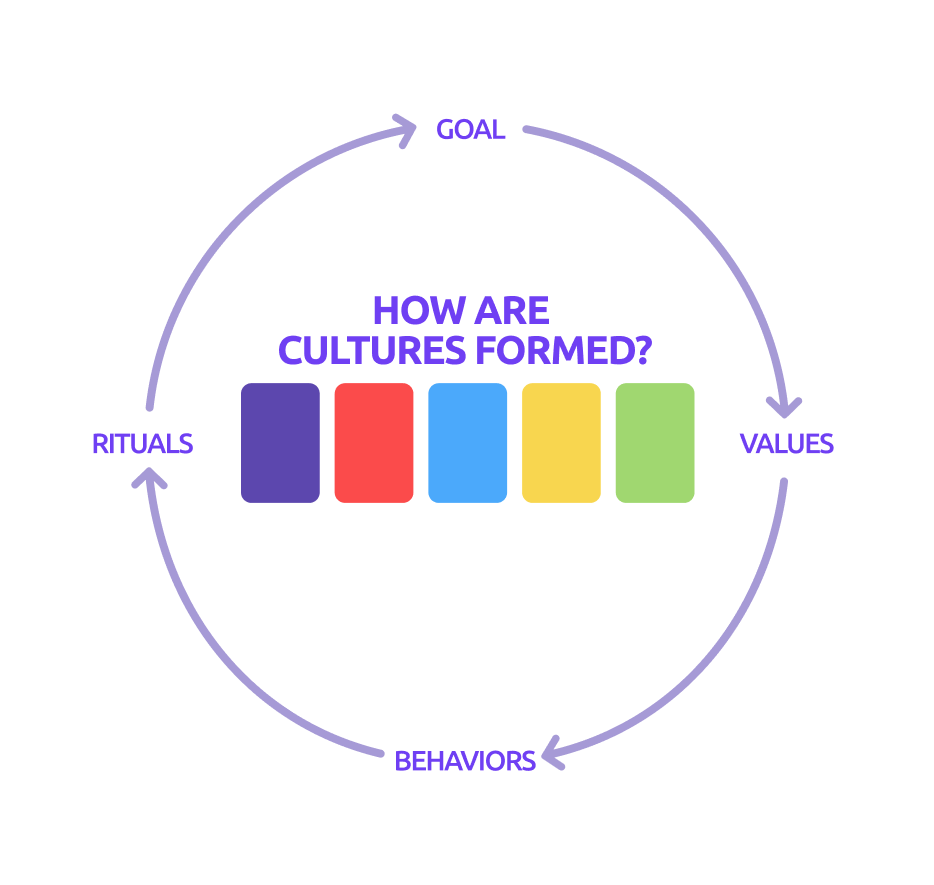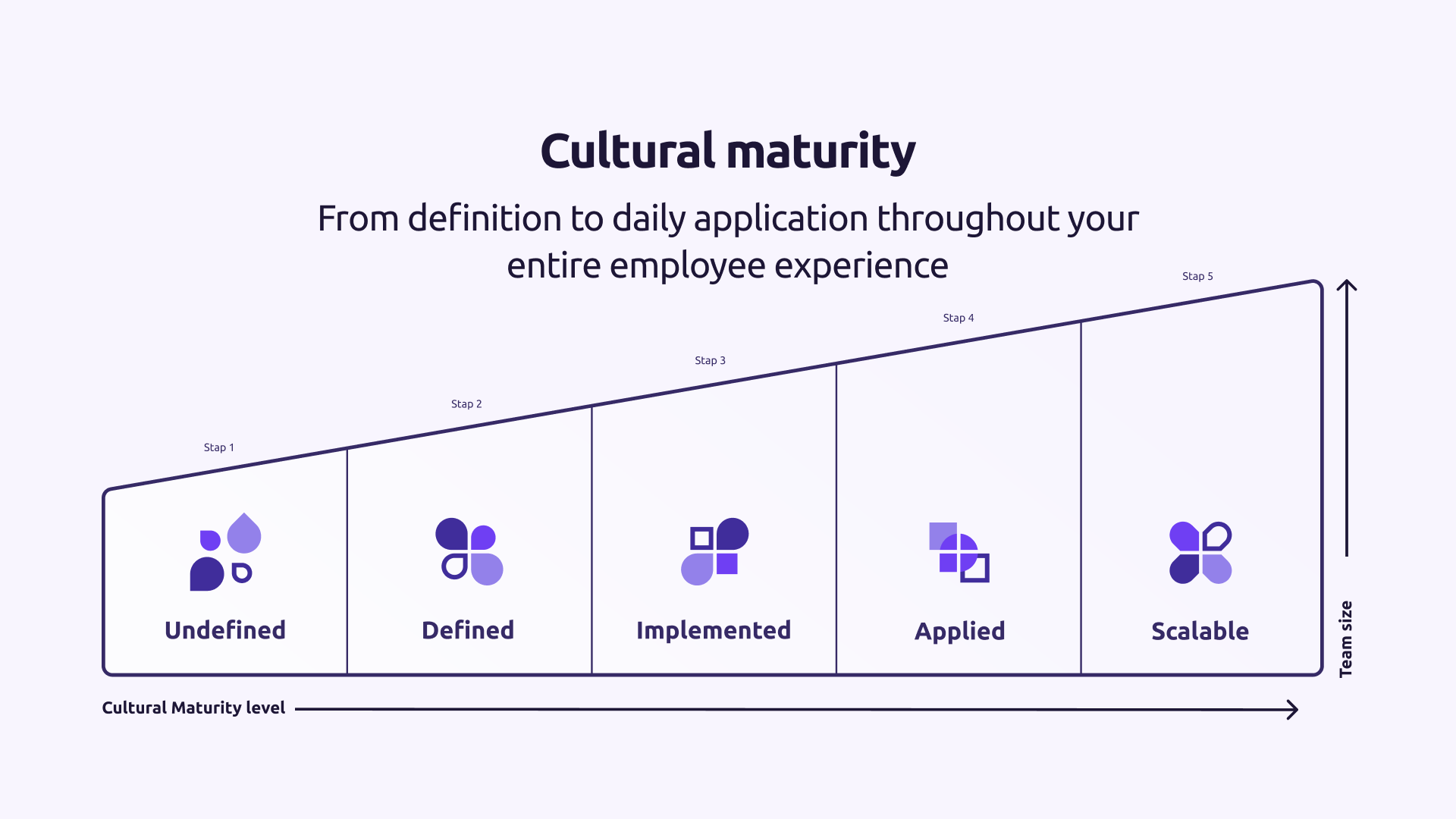The 5 steps that lead to cultural maturity.
The Pathway to a Strong, Scalable Organizational Culture.
The goal: A clear, flexible, and scalable culture
Whether you're considering talent attraction and retention, productivity, adaptability, or team happiness, teams with a strong internal culture perform better in all aspects. However, as important as a strong team culture is for business success, it can also be vulnerable. In fact, precisely when a team is successful and rapidly growing, it might hollow out and weaken a strong team culture. Other developments teams and companies face can also put team culture under pressure.
Often, rapid team growth or new leadership leads to weakening bonds and a shared culture. But this isn't necessarily the case. There are numerous large, rapidly growing organizations that have successfully retained their formula for cultural success while rapidly expanding their team size. Or maintained their cultural character while undergoing a change in direction or new leadership.
Apparently, these companies have succeeded in scaling their culture. They've reached a point where their culture has become part of the organization's DNA. Thus, their culture is no longer dependent on leadership or other specific cultural carriers. The culture is embraced by the entire team, successfully extending to new members. Consequently, their culture seems capable of welcoming and incorporating new team members without losing its strength. They possess the ability to continually evolve the culture and adjust it as needed to serve a changed business purpose and/or strategy.
This is Cultural Maturity: a culture supported by the entire team, adaptable to changes, and capable of growing with the team without losing its cultural strength.
Cultural Formation: What Works (and What Doesn't)
Every culture is unique. However, the way cultures form and continually evolve works the same way for every group of people. The path to getting there is built upon identical phases for every company.
To comprehend how and why these phases work, we must first consider how cultural formation actually operates.
"Culture = the sum of group behavior."
Culture is literally "created" by the group. The group owns and "produces" the culture. Hence, a culture can only be formed and adjusted by the group as a whole.
It's logical then that many employer efforts to shape or guide a culture have little or no effect. Employers often resort to well-intentioned means like posters, mugs, and undistinguished texts on their careers page to remind the team of their "shared" cultural values. But it remains one-sided communication. Consequently, the desired effect doesn't materialize.
Okay, so a poster on the wall with your Cultural Values doesn't work. But what does? To have an effect, every approach must embrace the following three principles:
- Every methodology to consciously shape a culture must be based on the simple fact that every culture, by definition, belongs to the group. Therefore, any attempt to steer a culture will demand involvement from the entire group. This creates an interesting paradox: "What is the desired culture?" isn't a democratic question. Yet, the culture is formed with the entire team.
- It's crucial to recognize that culture emanates from daily behavior. If the group's actual behavior changes, so does the culture. Culture is thus a matter of actions. Just determining together what the culture is or should be yields nothing. Everyone needs to be involved in its application.
- Finally: Culture is a dynamic, constantly changing phenomenon. It's not static. On one hand, this is good news: something constantly changing can be influenced and guided. However, on the other hand, you're never done and will continually need to shape your culture together with your team.
The good news: collectively, we've proven this is achievable for centuries.
The Success Formula: An Age-Old Recipe
Every culture consistently forms anew and is subject to change. But how do you influence the direction in which a culture develops? Regardless of the group type (it could be a religion, a sports team, or a company), every conscious group culture follows the same continuous process.

- Goal: What is the group's goal? What are they trying to achieve? Is it spiritual connection? Is it winning? Is it being the best in a specific industry? Whatever the group's goal, in every healthy culture, the goal is paramount. And the culture serves this goal.
- Values: The next question is, what are the crucial characteristics of the group to achieve that goal? How should the group interact in cooperation? If innovation and experimentation are crucial for success, then creativity is an absolute core value. If precision and optimization are the keys to success, then accuracy is a core value. What is crucial for success is what the group culture values.
- Behavior: Cultural values are like the pillars of a culture, but they're not what actually shapes your culture. Every culture arises from behavior. Behavior is how a particular value is practically applied. It's what actually happens (or doesn't happen) within the group.
- Rituals: Rituals are recurring moments where the group pauses together, remembering the shared goal, the crucial characteristics and values needed to achieve that goal, and the practical behavior associated with it. It aligns group behavior with the larger goal and continually shapes the culture.
What are these rituals in a business context? When thinking of rituals, you might first consider religious gatherings rather than team-building in a company. However, amusingly, companies have various recurring activities that foster group unity. Think of attracting and hiring new talent, welcoming and onboarding new team members, providing mutual feedback, evaluating each other's growth and performance, etc.
All these activities can be organized as "HR processes," primarily carried out by individuals with specific responsibilities. But you can also see and organize them as shared, culture-strengthening rituals, where the entire team participates, focusing on the greater goal and the group's values. It's where shared cultural values are continuously applied by the entire team.
"Cultural Maturity": The Path to Cultural Sophistication
Every team is unique. However, the path to genuine cultural maturity is identical for every team:

Phase 1: The culture is undefined
In this phase, the organizational culture is undefined and largely implicit. The team is generally driven by the actions and behavior of individual employees rather than a defined organizational identity. Attempts might initially be made to establish core values, but actual consistency is lacking.

Phase 2: The culture is defined and communicated
At this stage, the organization has clearly defined its ambition and the cultural values and behaviors that enable the team to achieve its goals. Utilizing leadership, cultural values and expectations are clearly communicated in a cultural manifesto. They are easily accessible to the entire team and actively conveyed to potential interested talent. The cultural values are written in a way that all team members can understand and apply them in their daily collaboration.
Every team finds its culture in words in its own language. But fundamentally, every Cultural Manifesto consists of the same building blocks.

Phase 3: Cultural Values Implemented in the Employee Journey
In this phase, cultural values are embedded within the structure and business processes of the organization. The organization has a clearly defined plan on how these values are integrated into growth paths, roles, and recurring rituals in the employee journey: recruitment, onboarding, performance management, employee development, and offboarding.

Phase 4: Cultural Values are Applied throughout the Employee Experience
In this phase, cultural values are tangible and perceptible from the initial conversation to the last working day. The organization transitions from the employee journey to the employee experience – all interactions are guided by cultural values. The entire team is supported and expected to apply these values in everything they do and contribute to the ongoing feedback loop between leadership and the team. This makes the culture measurable and transparent.

Phase 5: Culture is Leading, Adaptable & Scalable
In this phase, culture becomes part of the organization's DNA. Cultural insights drive decision-making, cultural values are owned by all employees, and the culture can welcome and assimilate new team members (scalable) without losing strength. There is a continuous ability to evolve and/or adjust the culture in service of the company's goals and strategy.

Consistency is Key
Starting by defining your Cultural Values and placing them at the core of some team rituals is a good beginning. However, for real impact, consistency is crucial. Not only consistency over time (continuing to do so) but also consistency throughout the entire employee journey: from new hire to offboarding. Because when certain stimuli within an employee journey contradict each other, the impact on culture will be limited.
Culture is a Journey, Not a Destination
The journey toward forming and expanding a scalable and resilient culture will differ for each group. Yet, there are clear stages in the process to shape it. Some teams will quickly go through all these stages, while others may take longer. But fundamentally, every team will go through each stage, simply because to reach a phase, the preceding phase must be completed.
Phase 5 is not a stable point where all checkboxes are ticked, and the culture automatically remains at a certain level. Even for the most mature and scalable cultures, they are continually reshaped every day. Therefore, continuous attention, energy, and dedication are necessary to maintain what's good, refine what can be improved, and collectively apply the values and behaviors that define the culture.
Lees meer blogs
Jr. Culture Consultant positie
Jr. Culture Consultant positie
SUMM zoekt een energieke, ambitieuze en scherpe Jr. Culture Consultant. Een ideale eerste of tweede baan om veel te leren, directe klantervaring op te doen, en meteen verantwoordelijkheid te krijgen. Als Jr. Culture Consultant sta je centraal in hoe wij onze klanten bedienen: van het begin van een relatie tot de doorlopende diensten die we leveren om onze klanten te helpen een sterke teamcultuur te bouwen en te onderhouden.